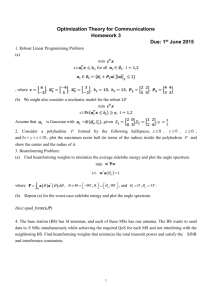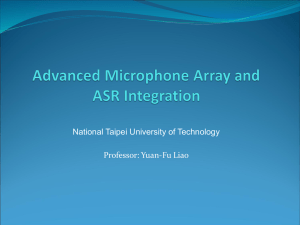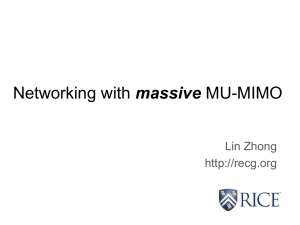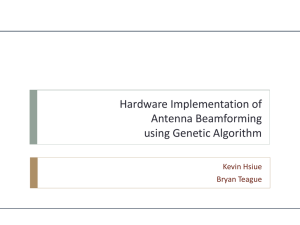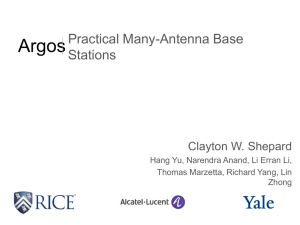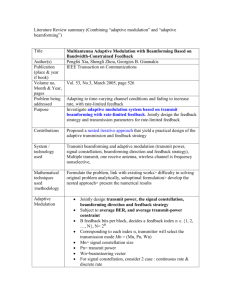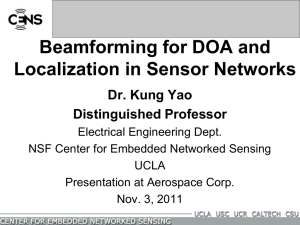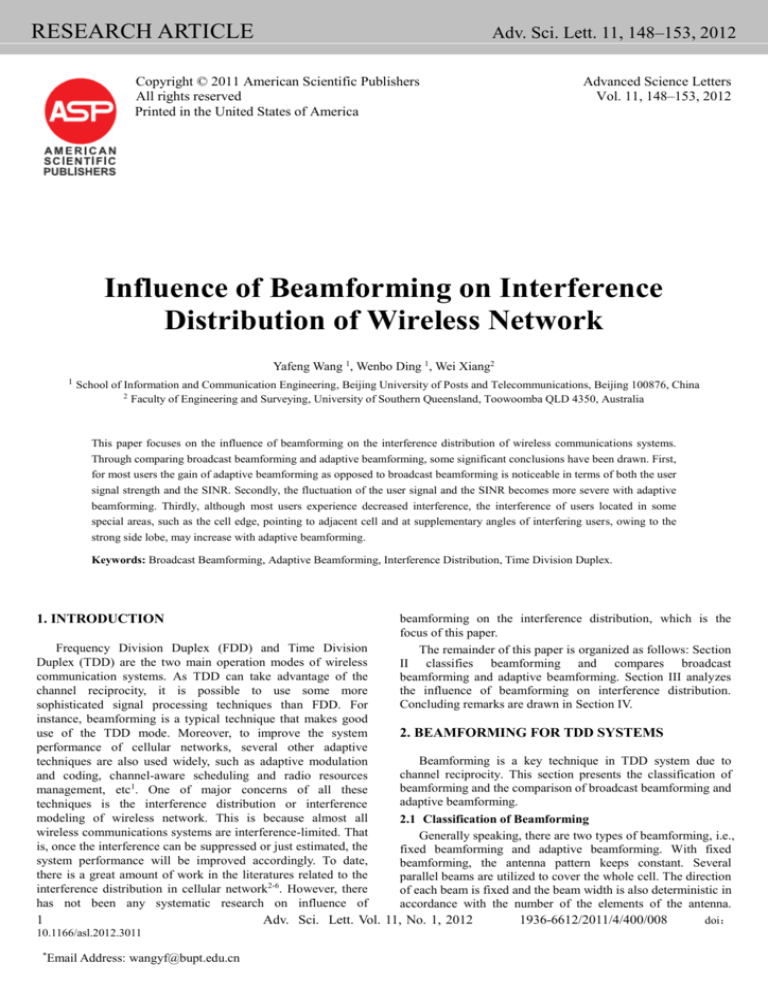
RESEARCH ARTICLE
Adv. Sci. Lett. 11, 148–153, 2012
Copyright © 2011 American Scientific Publishers
All rights reserved
Printed in the United States of America
Advanced Science Letters
Vol. 11, 148–153, 2012
Influence of Beamforming on Interference
Distribution of Wireless Network
Yafeng Wang 1, Wenbo Ding 1, Wei Xiang2
1
School of Information and Communication Engineering, Beijing University of Posts and Telecommunications, Beijing 100876, China
2 Faculty of Engineering and Surveying, University of Southern Queensland, Toowoomba QLD 4350, Australia
This paper focuses on the influence of beamforming on the interference distribution of wireless communications systems.
Through comparing broadcast beamforming and adaptive beamforming, some significant conclusions have been drawn. First,
for most users the gain of adaptive beamforming as opposed to broadcast beamforming is noticeable in terms of both the user
signal strength and the SINR. Secondly, the fluctuation of the user signal and the SINR becomes more severe with adaptive
beamforming. Thirdly, although most users experience decreased interference, the interference of users located in some
special areas, such as the cell edge, pointing to adjacent cell and at supplementary angles of interfering users, owing to the
strong side lobe, may increase with adaptive beamforming.
Keywords: Broadcast Beamforming, Adaptive Beamforming, Interference Distribution, Time Division Duplex.
1. INTRODUCTION
Frequency Division Duplex (FDD) and Time Division
Duplex (TDD) are the two main operation modes of wireless
communication systems. As TDD can take advantage of the
channel reciprocity, it is possible to use some more
sophisticated signal processing techniques than FDD. For
instance, beamforming is a typical technique that makes good
use of the TDD mode. Moreover, to improve the system
performance of cellular networks, several other adaptive
techniques are also used widely, such as adaptive modulation
and coding, channel-aware scheduling and radio resources
management, etc1. One of major concerns of all these
techniques is the interference distribution or interference
modeling of wireless network. This is because almost all
wireless communications systems are interference-limited. That
is, once the interference can be suppressed or just estimated, the
system performance will be improved accordingly. To date,
there is a great amount of work in the literatures related to the
interference distribution in cellular network2-6. However, there
has not been any systematic research on influence of
1
beamforming on the interference distribution, which is the
focus of this paper.
The remainder of this paper is organized as follows: Section
II classifies beamforming and compares broadcast
beamforming and adaptive beamforming. Section III analyzes
the influence of beamforming on interference distribution.
Concluding remarks are drawn in Section IV.
2. BEAMFORMING FOR TDD SYSTEMS
Beamforming is a key technique in TDD system due to
channel reciprocity. This section presents the classification of
beamforming and the comparison of broadcast beamforming and
adaptive beamforming.
2.1 Classification of Beamforming
Generally speaking, there are two types of beamforming, i.e.,
fixed beamforming and adaptive beamforming. With fixed
beamforming, the antenna pattern keeps constant. Several
parallel beams are utilized to cover the whole cell. The direction
of each beam is fixed and the beam width is also deterministic in
accordance with the number of the elements of the antenna.
Adv. Sci. Lett. Vol. 11, No. 1, 2012
10.1166/asl.2012.3011
*
Email Address: wangyf@bupt.edu.cn
1936-6612/2011/4/400/008
doi:
RESEARCH ARTICLE
Adv. Sci. Lett. 4, 400–407, 2011
考虑信道广播波束方向性增益图
Through measuring the direction of the user signal, the antenna
can choose proper a weighting vector to ensure its major lobe
points to the intended user, and can thus improve the signal to
interference plus noise ratio (SINR). The widely used broadcast
beamforming falls under fixed beamforming. Different from
fixed beamforming, adaptive beamforming changes the
weighting vector to adapt to the variation of the channel impulse
response. The two most common beamforming criteria are the
maximization of the received power and the maximization of the
SINR. The most popular adaptive beamforming algorithm is
eigenvalue based beamforming (EBB). Through the singular
value decomposition (SVD) of the channel matrix, EBB uses the
eigenvectors corresponding to the maximum eigenvalue for
single stream transmission or the maximum and secondary
maximum eigenvalues for dual streams transmission.
2.2 Comparison of Broadcast Beamforming and Adaptive
Beamforming
The dual-polarized broadcast beamforming with a 65
degree beam width is investigated in detail. The weighting
vector of each port is listed in table 1.
Table 1. Weighting Vector of Broadcast Beamforming
Ports
1
2
3
4
5
6
Amplitude
0.48 0.48
1
1
1
1
Phase
180
0
0
0
0
180
7
8
0.48 0.48
0
0
The antenna pattern of this weighting vector without
considering channel is illustrated in figure 1. If we take the
channel into consideration, the antenna pattern of this
weighting vector will be like figure 2, which shows the antenna
pattern is affected by the real channel impulse response,
although it still keeps the most features of broadcast
beamforming.
不考虑信道广播波束方向性增益图
90
50
60
40
30
150
30
20
10
180
0
210
330
240
300
270
Fig. 2. The antenna pattern of broadcast beamforming with
taking channel into consideration
3 IMPACT OF BEAMFORMING ON INTERFERENCE
DISTRIBUTION
To analyze the impact of beamforming on interference
distribution, we take the TD-SCDMA wireless network as an
example, in which both R4 and R5 protocols are investigated7-8.
Note that the obtained conclusions are also applicable to other
TDD systems, such
as LTE TDD or TD-LTE.
扇 区 正 对 方 向 EBB增 益 图 和 广 播 波 束 增 益 图 对 比
25
20
15
10
5
0
50
120
90
120
60
-5
40
-10
30
150
30
-15
20
-20
10
-25
-200
180
0
-150
-100
-50
0
50
100
红 色 是 EBB 蓝 色 是 广 播 波 束
150
200
Fig. 3. Antenna pattern comparison of broadcast beamforming
and adaptive beamforming
3.1 Simulation Parameters
210
330
The simulation parameters are listed in table 2.
Table 2. Simulation Parameters
240
300
270
Fig. 1. The antenna pattern of broadcast beamforming without
considering channel
The comparison of the antenna patterns for broadcast
beamforming and adaptive beamforming is shown in figure 3. It
shows that the mainlobe gain of adaptive beamforming is 5dB
higher than that of broadcast beamforming, and the 3dB
mainlobe width of adaptive beamforming is much narrower
than that of broadcast beamforming.
Parameter
Value
Radio network
TD-SCDMA R4 and R5
Cellular layout
3-sectorized Hexagonal grid
with 7 cells wrap-around
UE distribution
10 UE/sector , Uniform
Distribution
Channel model
UMi(Uran Micro cell)
Traffic model
Full buffer
2
RESEARCH ARTICLE
Adv. Sci. Lett. 11, 148–153, 2012
开闭EBB干扰均值之比
1
Node B transmission
power
43 dBm
Antenna number
Node B- -UE: 81
Shadowing standard
deviation
Log Normal distribution with
0 mean , 8 dB standard
deviation
0.9
0.8
0.7
F(x)
0.6
0.5
0.4
0.3
Thermal
density
noise
-174 dBm/Hz
0.2
0.1
Scheduling scheme
Persistant scheduling one user
within one subframe
Detection algorithm
Intra-cell Minimum Mean
Square Error (MMSE)
0
-8
-6
-4
-2
0
2
4
6
dB
Fig. 4. Comprasion of interference mean between broadcast
beamforming and adaptive beamforming
开闭EBB干扰标准差之比
1
3.2 Analytical Method
Five statistical metrics including the mean, standard
T
deviation, Dmax
, variation period and coherent time, are
0.9
0.8
0.7
investigated to compare the mean value, variation range and
variation speed of the interference, user signal, post-SINR for
the wireless network with broadcast beamforming and adaptive
beamforming.
T
Here Dmax
is defined as follows:
F(x)
0.6
0.4
0.3
Assume ISCPn,s is the measured Interference Signal Code
Power (ISCP), where n is the frame number and s is slot
number.
T
is the maximum variation range within a fixed time
Dmax
duration T. Here assuming that T=1s.
First, we divide the measured ISCPn,s into L sequences
I t with fixed time duration T and sequence length l.
0.2
0.1
0
-10
1
1
l
5
10
开闭EBB干扰Dmax之比
0.9
l
0.8
0.7
0.6
F(x)
follows
(1)
DtT1 =max (I t1)- min (I t1)
0.3
1
D =average(D ,D , ,D )
T
t0
T
t1
0.5
0.4
T can be calculated as
After obtaining all the DtT , Dmax
T
tL1
(2)
T , we know that it represents the
From the definition of Dmax
interference variation range.
Now take the interference mean before detection as an
example. We calculate the interference mean of the systems
with broadcast beamforming and adaptive beamforming and
obtain their difference in dB. Then, we draw the Cumulative
Distribution Function (CDF) of these differences. If ordinate
0.3 corresponds to abscissa 0 on the CDF curve, the mean of
interference of 30% of users decreases when using adaptive
beamforming and that of the remainder 70% users increases.
Figure 4 shows that when adaptive beamforming is in use,
the mean of the interference 60% of users decreases, and that of
40% of users increases. This is because for majority users
adaptive beamforming has a much narrower mainlobe width
and thus decreases the interference to other users. However, if
the intended user is located in some special areas, such as the
cell edge, pointing to an adjacent cell and at supplementary
angles of interfering users, then owing to the strong side lobe,
the interference may increase when adaptive beamforming is
employed.
3
0
dB
1
1
T
max
-5
Fig. 5. Comprasion of interference standard deviation between
broadcast beamforming and adaptive beamforming
Let I t ISCPn , s ,, ISCPn , s be the ISCPn,s within time
interval t1 , t1 T and t 5n 0.675s for the TD-SCDMA system.
Then, the maximum variation range DtT in t1 , t1 T is as
1
0.5
0.2
0.1
0
-10
-5
0
5
10
15
dB
Fig. 6.
T
Comprasion of interference Dmax
between broadcast
beamforming and adaptive beamforming
As can be observed from figures 5 and 6, when adaptive
beamforming is in use, the interference of 60% of users
fluctuates more severely. The variation range is mainly affected
by the fluctuation of fast fading between the interfering base
station and intended user, and adaptive beamforming intensifies
the fast fading fluctuation of the equivalent channel.
As abscissa 0 corresponds to ordinate 0.9 for both figures 7
and 8, this means that with adaptive beamforming, the
interference of 90% of users fluctuates faster. This is easy to
understand because when both the power and location are fixed,
the interference variation is mainly affected by fast fading,
which is determined by both the channel and weighting vector.
And the weighting vector of broadcast beamforming is fixed
but that of adaptive beamforming varies with channel.
RESEARCH ARTICLE
Adv. Sci. Lett. 4, 400–407, 2011
开闭EBB干扰变化周期之差
1
with an increased interference mean, more often than not, the
increment of the interference mean is less than 3dB. At the same
time, the increment of the user signal strength is always larger
than 3dB. Therefore, the SINR mean of most users will increase.
0.9
0.8
0.7
开闭EBB有用信号标准差之比
0.6
F(x)
1
0.5
0.9
0.4
0.8
0.3
0.7
0.2
0.6
0
-25
F(x)
0.1
-20
-15
-10
-5
0
5
0.5
10
TTI
0.4
Fig. 7. Comprasion of interference variation period between
broadcast beamforming and adaptive beamforming
0.3
0.2
开闭EBB干扰相干时间之差
0.1
1
0
0.9
0
2
4
6
dB
0.8
10
12
Fig. 10. Comprasion of user signal standard deviation between
broadcast beamforming and adaptive beamforming
0.7
0.6
开闭EBB有用信号Dmax之比
0.5
1
0.4
0.9
0.3
0.8
0.2
0.7
0.1
0.6
0
-20
-15
-10
-5
0
5
10
15
F(x)
F(x)
8
TTI
0.5
0.4
0.3
Fig. 8. Comprasion of interference coherent time between
broadcast beamforming and adaptive beamforming
0.2
0.1
开闭EBB有用信号均值之比
1
0
-2
0.9
2
4
6
8
10
12
dB
0.8
T
Fig. 11. Comprasion of user signal Dmax
between broadcast
beamforming and adaptive beamforming
0.7
0.6
开闭EBB有用信号变化周期之差
0.5
1
0.4
0.9
0.3
0.8
0.2
0.7
0.1
0.6
0
3
4
5
6
7
8
9
10
11
12
dB
Fig. 9. Comprasion of user signal mean value between
broadcast beamforming and adaptive beamforming
F(x)
F(x)
0
0.5
0.4
0.3
0.2
0.1
Figure 9 shows that adaptive beamforming can obtain at
least 3dB gain in terms of the user signal mean. Therefore,
adaptive beamforming is able to remarkably improve the
performance of TDD systems.
Figures 10 and 11 show that almost all the users’ signal
fluctuates more severly with adaptive beamforming for the
same reason as for the interference fluctuation.
As abscissa 0 corresponds to ordinate 0.5 for both figures
12 and 13, this indicates adaptive beamforming does not impact
on the fluctation of the user signal.
Figure 14 suggests that the mean of the SINR of more than
97% users increases with adaptive beamforming. When adaptive
beamforming is in use, the numbers of the users with increased
and decreased interference mean are half to half. Among those
0
-20
-10
0
10
TTI
20
30
40
Fig. 12. Comprasion of user signal variation period between
broadcast beamforming and adaptive beamforming
Figures 15 and 16 show that the SINRs of more than 97% of
the users fluctuate more severely with adaptive beamforming.
This phenomenon will dramatically affect the use of many key
techniques in wireless networks that depend on the channel
quality indicator (CQI) feedback. Owing to the fast fluctuation,
the CQI feedback may not be able to keep up with variation of
the real SINR.
The simulation results of TD-SCDMA R4 are basically
4
RESEARCH ARTICLE
Adv. Sci. Lett. 11, 148–153, 2012
similar to those of TD-SCDMA R5 discussed above and thus
omitted owing to limited
space.
开闭EBB有用信号相干时间之差
1
0.9
0.8
0.7
F(x)
0.6
0.5
0.4
adaptive beamforming. Therefore, the adaptive beamforming
system has a stricter requirement on the CQI feedback. Thirdly,
although the interference of most users decreases, the
interference of users located in some special areas, such as the
cell edge, pointing to an adjacent cell and at supplementary
angles of interfering users, owing to the strong side lobe, may
increase with adaptive beamforming. Hence, for users located
at the cell edge, some special fixed beamforming is superior to
adaptive beamforming.开闭EBB检测后SINR Dmax之比
1
0.3
0.9
0.2
0.8
0.1
0.7
0
-15
15
10
5
0
-5
-10
0.6
20
F(x)
TTI
Fig. 13. Comprasion of user signal coherent time between
broadcast beamforming and adaptive beamforming
0.5
0.4
0.3
开闭EBB检测后SINR均值之比
0.2
1
0.1
0.9
0
-5
0.8
0
5
0.7
15
20
25
T between broadcast
Fig. 16. Comprasion of SINR Dmax
beamforming and adaptive beamforming
0.6
F(x)
10
dB
0.5
0.4
0.3
ACKNOWLEDGMENTS
0.2
0.1
0
-5
0
5
10
15
20
This paper is supported by Key project (2011ZX03003-00201).
dB
Fig. 14. Comprasion of SINR mean value between broadcast
beamforming and adaptive beamforming
REFERENCES
[1] Theodore S. Rappaport, Wireless communications: principles and
开闭EBB检测后SINR标准差之比
practice, second edition, Prentice Hall, USA, 2002
1
0.9
[2] H. Boche, M. Schubert, A unifying approach to interference
0.8
modeling for wireless networks, IEEE Trans. on Signal
Processing, vol. 58 , No. 6, March 2010, pp. 3282 – 3297.
Shinuk Woo, Hwangnam Kim, Estimating link reliability in
wireless networks: an empirical study and interference modeling,
Proceedings of INFOCOM 2010, IEEE Press, San Diego, CA,
USA, May 2010, pp.1 – 5.
Yafeng Wang, Guoxin Wei, Wei Xiang, Approximate inter-cell
interference modeling for cellular network, The Journal of China
Universities of Posts and Telecommunications, vol. 18, no. 3,
June 2011, pp. 75–79
P. Skillermark, M. Almgren, D. Astely, M. Lundevall, M. Olsson,
Simplified interference modeling in multi-cell multi-antenna
radio network simulations, Proceedings of VTC-Spring 2008,
Marina Bay, Singapore, May 2008, IEEE Press, pp.1886 – 1890
Y.Le Helloco, J.-M. Amen, R. Lerbour, B. Breton, 3-Dimensional
Interference Modeling for Cellular Networks, Proceedings of
VTC-Fall 2006, Montreal, QC, Canada, Sept. 2006, IEEE Press,
pp.1- 5
3GPP, Overview of 3GPP Release 4 V1.1.2, 2010-02
3GPP, Overview of 3GPP Release 5 V0.1.1, 2010-02
0.7
[3]
F(x)
0.6
0.5
0.4
[4]
0.3
0.2
0.1
0
-5
0
5
10
dB
15
20
25
Fig. 15. Comprasion of SINR standard deviation between
broadcast beamforming and adaptive beamforming
[5]
[6]
4. CONCLUSIONS
Beamforming is a key technique in TDD wireless
communications systems as it can take advantage of the channel
reciprocity. This paper focuses on the impact of beamforming on
the interference in cellular networks. Through comparing
broadcast beamforming and adaptive beamforming, a number of
important findings are obtained in this paper. First, for most
users the gain of adaptive beamforming relative to broadcast
beamforming is noticeable whether in terms of the user signal
strength or the SINR. Secondly, the fluctuation of the user
signal strength and the SINR becomes more severe with
5
[7]
[8]
Received: 1 August 2011. Accepted: 15 October 2011


